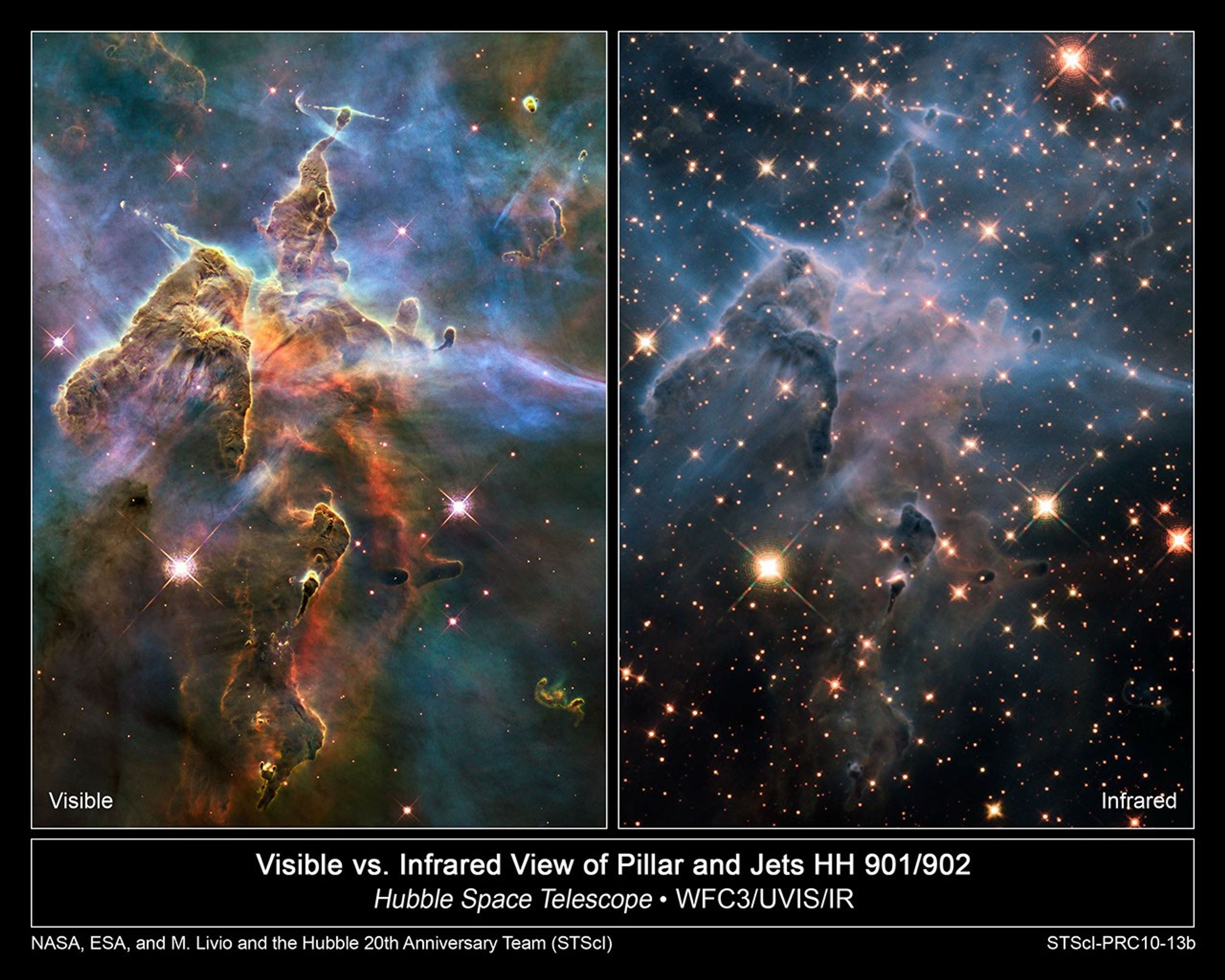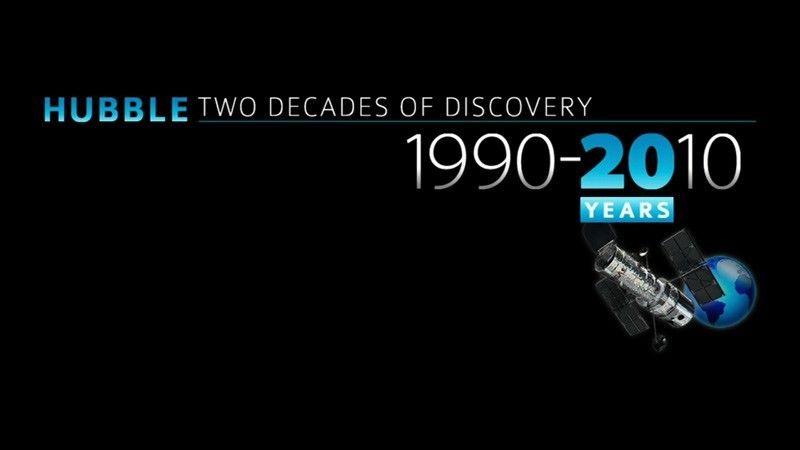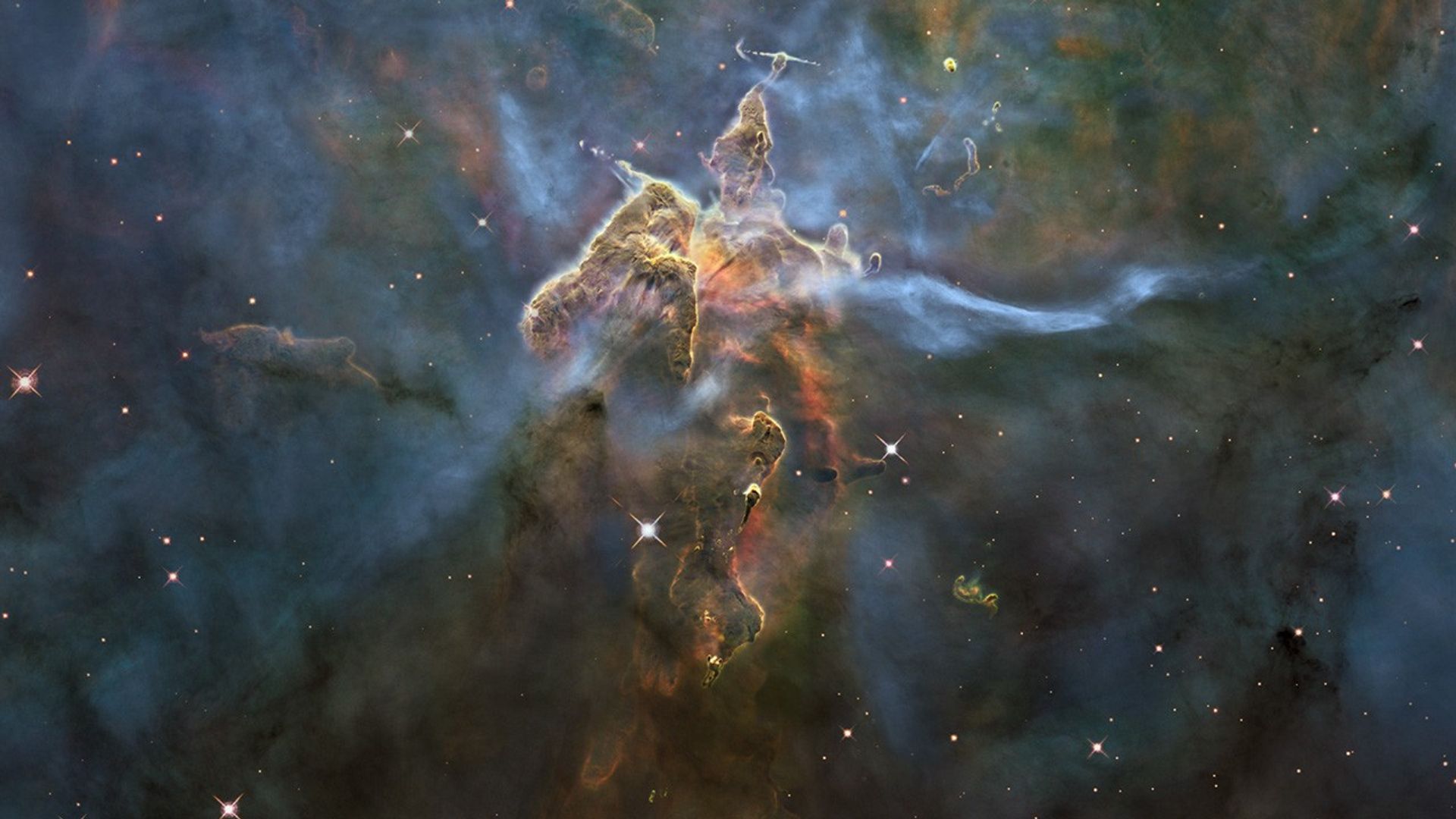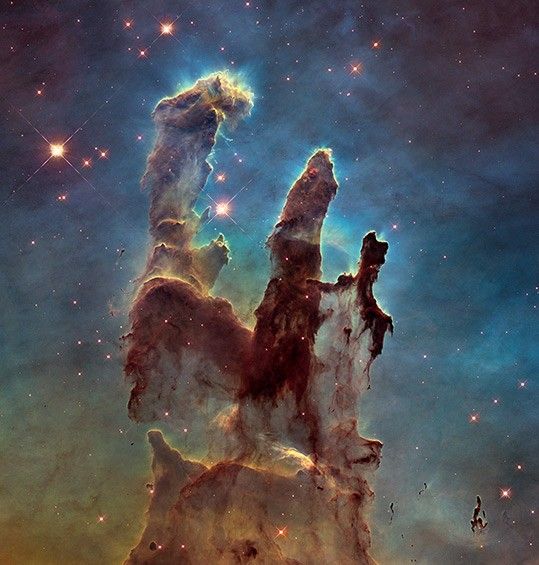NASA's best-recognized, longest-lived, and most prolific space observatory zooms past a threshold of 20 years of operation this month. On April 24, 1990, the space shuttle and crew of STS-31 were launched to deploy the Hubble Space Telescope into a low Earth orbit. What followed was one of the most remarkable sagas of the space age. Hubble's unprecedented capabilities made it one of the most powerful science instruments ever conceived by humans, and certainly the one most embraced by the public. Hubble discoveries revolutionized nearly all areas of current astronomical research, from planetary science to cosmology. And, its pictures were unmistakably out of this world.
At times Hubble's starry odyssey played out like a space soap opera, with broken equipment, a bleary-eyed primary mirror, and even a space shuttle rescue/repair mission cancellation. But the ingenuity and dedication of Hubble scientists, engineers, and NASA astronauts have allowed the observatory to rebound time and time again. Its crisp vision continues to challenge scientists with exciting new surprises and to enthrall the public with ever more evocative color images.
NASA, the European Space Agency (ESA), and the Space Telescope Science Institute (STScI) are celebrating Hubble's journey of exploration with a stunning new picture, online educational activities, an opportunity for people to explore galaxies as armchair scientists, and an opportunity for astronomy enthusiasts to send in their own personal greetings to Hubble for posterity.
NASA is releasing today a brand new Hubble photo of a small portion of one of the largest seen star-birth regions in the galaxy, the Carina Nebula. Towers of cool hydrogen laced with dust rise from the wall of the nebula. The scene is reminiscent of Hubble's classic "Pillars of Creation" photo from 1995, but is even more striking in appearance. The image captures the top of a three-light-year-tall pillar of gas and dust that is being eaten away by the brilliant light from nearby bright stars. The pillar is also being pushed apart from within, as infant stars buried inside it fire off jets of gas that can be seen streaming from towering peaks like arrows sailing through the air.
Hubble fans worldwide are being invited to share the ways the telescope has affected them. They can send an e-mail, post a Facebook message, use the Twitter hashtag #hst20, or send a cell phone text message. Or, they can visit the "Messages to Hubble" page on http://hubblesite.org, type in their entry, and read selections from other messages that have been received. Fan messages will be stored in the Hubble data archive along with the telescope's many terabytes of science data. Someday, future researchers will be able to read these messages and understand how Hubble had such an impact on the world.
The public will also have an opportunity to be at-home scientists by helping astronomers sort out the thousands of galaxies seen in a deep Hubble observation. STScI is partnering with the Galaxy Zoo consortium of scientists to launch an Internet-based astronomy project (http://hubble.galaxyzoo.org) where amateur astronomers can peruse and sort galaxies from Hubble's deepest view of the universe into their classic shapes: spiral, elliptical, and irregular. Dividing the galaxies into categories will allow astronomers to study how they relate to one another and provide clues that might help scientists understand how they formed.
For students, STScI is opening an education portal called "Celebrating Hubble's 20th Anniversary". It offers links to "fun facts" and trivia about Hubble, a news story that chronicles the Earth-orbiting observatory's life and discoveries, and the IMAX "Hubble 3D" educator guide. An anniversary poster containing Hubble's "hall-of-fame" images, including the Eagle Nebula and Saturn, is also being offered with downloadable classroom activity information.
To date, Hubble has looked at over 30,000 celestial objects and amassed over one-half million pictures in its archive. The last heroic astronaut servicing mission to Hubble in May 2009 made it 100 times more powerful than when it was launched. In addition to its irreplaceable scientific importance, Hubble brings cosmic wonders into millions of homes and schools every day. For the past 20 years the public has become co-explorers with this wondrous observatory.
Background Information: Hubble's Greatest Scientific Achievements
The Hubble Space Telescope is one of the most powerful and prolific science instruments ever made, earning a place as one of the technical wonders of the modern world. From its lofty perch 350 miles above Earth, Hubble sees farther and sharper than any previous telescope, producing breathtaking images that have astounded astronomers and the public. Its discoveries have revolutionized nearly all areas of astronomy, from planetary science to cosmology. The telescope has imaged more than 30,000 celestial objects, snapping more than 570,000 pictures.
A series of heroic astronaut servicing missions to Hubble have made it the longest-operating space observatory ever built. Thanks to routine maintenance and upgrades Hubble is 100 times more powerful than when it was launched. In addition to its scientific importance, Hubble brings cosmic wonders into millions of homes and schools worldwide, allowing the public to be co-explorers with this wondrous observatory.
Here are some of Hubble's top science discoveries.
An Accelerating Universe
By witnessing bursts of light from faraway exploding stars, Hubble helped astronomers discover dark energy, which pervades our universe. This mysterious energy exerts a repulsive force that works against gravity.
The telescope also provided evidence that dark energy has been engaged in a tug of war with gravity for billions of years. Hubble observations showed that the powerful energy is shoving galaxies away from each other at ever-increasing speeds, making the universe expand at an accelerating pace.
But dark energy wasn't always in the driver's seat. By studying distant supernovas, Hubble traced dark energy all the way back to 9 billion years ago, when the universe was less than half its present size. During that epoch, dark energy was struggling with gravity for control of the cosmos. Dark energy finally won the struggle with gravity about 5 billion years ago.
By knowing more about how dark energy behaves over time, astronomers hope to gain a better understanding of what it is. Astronomers still do not know what dark energy is, even though it appears to comprise about 70 percent of the universe's energy.
How Old Is the Universe?
Some people hate to reveal their age, and the universe, it seems, is no different. Before Hubble was launched, astronomers had been trying for many years to pin down the universe's age. The method relied on determining the expansion rate of the universe, a value called the Hubble constant. Their values for the Hubble constant were highly uncertain. Consequently, their calculations for the universe's age ranged from 10 billion to 20 billion years.
One of Hubble's key duties was to help astronomers determine a precise age for the universe. The telescope's keen vision helped astronomers accomplish that goal by measuring the brightness of dozens of pulsating stars called Cepheid variables, which are a thousand times brighter than the Sun. By knowing their brightness, astronomers then calculated the stars' distance from Earth. From this study and other related analyses, astronomers determined the Hubble constant and the universe's age to an accuracy of about 5 percent. By their calculations, the universe is about 13.75 billion years old.
Galaxies From the Ground Up
Hubble's surveys of deep space showed that the universe was different long ago, providing evidence that galaxies grew over time through mergers with other galaxies to become the giant galaxies we see today.
The telescope snapped images of galaxies in the faraway universe in a series of unique observations, including the Hubble Deep Fields and the Hubble Ultra Deep Field. In the most recent foray into the universe's farthest regions, Hubble's newly installed Wide Field Camera 3 produced the deepest photographs of the universe in visible and near-infrared light and uncovered galaxies that lived when the universe was only 600 million years old.
All of the "Deep Field" observations have shed light on galaxy evolution. The galaxies spied by Hubble are smaller and more irregularly shaped than today's grand spiral and elliptical galaxies, reinforcing the idea that large galaxies built up over time as smaller galaxies collided and merged.
By studying galaxies at different epochs, astronomers can see how galaxies change over time. The process is analogous to a very large scrapbook of pictures documenting the lives of children from infancy to adulthood.
Hubble also probed the dense, central regions of galaxies and provided decisive evidence that supermassive black holes reside in the centers of almost all large galaxies. Giant black holes are compact "monsters" weighing millions to billions the mass of our Sun. Their gravity is so strong that they gobble up any material that ventures near them.
These elusive "eating machines" cannot be observed directly, because nothing, not even light, escapes their clutches. The telescope provided indirect, yet compelling, evidence of their existence. Hubble helped astronomers determine the masses of several black holes by measuring the velocities of material whirling around them.
Hubble's census of more than 30 galaxies showed an intimate relationship between galaxies and their resident black holes. The survey revealed that the black hole's mass is dependent on the weight of its host galaxy's central bulge of stars. The bigger the bulge of stars, the more massive the black hole. This close relationship means that black holes may have evolved with their host galaxies, feasting on a measured diet of gas and stars residing in the hearts of those galaxies.
Worlds Beyond Our Sun
At the time of Hubble's launch in 1990, astronomers had not found a single planet outside our solar system. Now there are more than 400 extrasolar planets, most of them discovered by ground-based telescopes. But Hubble has made some unique contributions to the planet hunt.
The telescope demonstrated that our Milky Way Galaxy is probably brimming with billions of planets. Peering into the crowded bulge of our Milky Way Galaxy, Hubble observed 180,000 stars and nabbed 16 potential alien worlds orbiting a variety of stars. Five of the candidates represent a new type of extreme planet. Dubbed Ultra-Short-Period Planets, these objects whirl around their stars in less than an Earth day. Astronomers made the discoveries by measuring the slight dimming of a star as a planet passed in front of it, an event called a transit.
The transit method was used again to make the first measurements of the atmospheric makeup of at least two extrasolar planets. The Hubble observations showed that the atmosphere of a known extrasolar planet contains sodium, oxygen, carbon, and hydrogen. A similar study of another alien world revealed probable signs of carbon dioxide, methane, and water. These two Jupiter-sized planets are too hot for life. The Hubble observations demonstrate, however, that the basic chemistry for life can be measured on planets orbiting other stars.
Finally, Hubble made the first visible-light image of an extrasolar planet circling the nearby, bright southern star Fomalhaut, located 25 light-years away in the constellation Piscis Australis. An immense debris disk about 21.5 billion miles across surrounds the star. The planet is orbiting 1.8 billion miles inside the disk's sharp inner edge, about 10 times the distance of Saturn from the Sun.
Shining a Light on Dark Matter
Astronomers used Hubble to make the first three-dimensional map of dark matter, an invisible form of matter that makes up most of the universe's mass and forms its underlying structure. Dark matter's gravity allows normal matter in the form of gas and dust to collect and build up into stars and galaxies.
Although astronomers cannot see dark matter, they can detect its influence in galaxy clusters by observing how its gravity bends and distorts the light of more distant background galaxies, a phenomenon called gravitational lensing.
Using Hubble's sharp view, astronomers used the gravitational lensing technique to construct the three-dimensional map by studying the warped images of half a million faraway galaxies. The new map provides the best evidence to date that normal matter, largely in the form of galaxies, accumulates along the densest concentrations of dark matter. The map stretches halfway back to the beginning of the universe and reveals a loose network of dark-matter filaments.
Astronomers also used Hubble to observe dark matter's distribution in the titanic collisions of clusters of galaxies. In one case, a combination of Hubble and Chandra X-ray observations suggests that dark matter and normal matter in the form of hot gas were pulled apart by the smashup between two groupings of galaxies, known as the Bullet Cluster.
In a Hubble gravitational lensing study of another galaxy cluster, astronomers discovered a ghostly ring of dark matter that formed long ago during a clash between two groups of massive galaxies. Astronomers have long suspected that such clusters would fly apart if they relied only on the gravity from their visible stars. The ring is a ripple of dark matter that was pulled apart from normal matter during the collision.
Computer simulations of galaxy cluster collisions show that when two clusters smash together, the dark matter flows through the center of the combined cluster. As the dark matter moves outward from the core, it begins to slow down under the pull of gravity and pile up.
Background Information: Hubble Trivia 2010
Hubble does not travel to stars, planets, and galaxies. It takes pictures of them as it whirls around Earth at 17,500 miles an hour.
In its 20 years of viewing the heavens, NASA's Hubble Space Telescope has made more than 930,000 observations and snapped over 570,000 images of 30,000 celestial objects.
In its 20-year lifetime the telescope has made more than 110,000 trips around our planet.
With those trips, Hubble has racked up plenty of frequent-flier miles, about 2.8 billion, which is Neptune's average distance from the Sun.
The 20 years' worth of observations has produced more than 45 terabytes of data, enough information to fill nearly 5,800 DVDs.
Each month the orbiting observatory generates more than 360 gigabytes of data, which could fill the storage space of an average home computer.
Astronomers using Hubble data have published more than 8,700 scientific papers, making it one of the most productive scientific instruments ever built. In 2009 scientists published 648 journal articles on Hubble telescope data.


















































